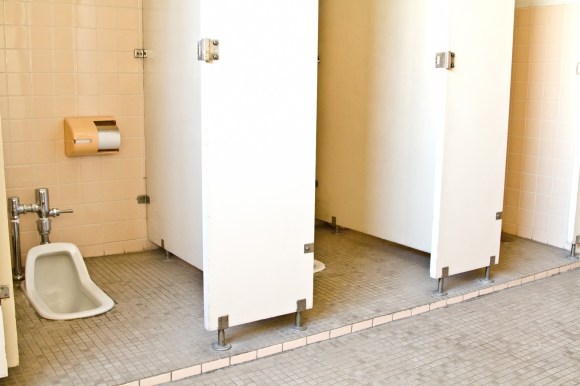
Japanese Twitter user reopens debate on Japanese-style squat toilet etiquette, but is it just a flush in the pan?
Japan may be famous for its all-singing, all-dancing “washlet” toilets with their warmed seats, auto-lifting lids and more buttons and nozzles than a fire engine wearing a cardigan, but the traditional Japanese-style toilet deserves to be equally well-known for its ability to puzzle and confuse even the people who are supposed to know how to use it, let alone foreign visitors.
Like a porcelain trough in the ground, the Japanese-style “squat” toilet has gradually been replaced by Western-style toilets but can still be found in places as diverse as public toilets in parks or motorway service stations and upscale department stores. You use the toilet by straddling it with one foot either side but which way should you be facing? Japanese Twitter user @mikaduki_neko reignited the online debate by suggesting that the origins of the “kinkakushi“, the hood-like part that covers the drainage hole, mean that you should be facing away from it rather than towards as most Japanese are taught.
以前話題になった時
— 三日月ネコ🧩 (@mikaduki_neko) December 9, 2017
みんな和式トイレの使い方間違えてるという
事実に驚愕したやつのまとめ pic.twitter.com/DUynj94Ni0
According to @mikaduki_neko, the kinkakushi was originally a wooden stand where the hygiene-conscious samurai wanting to drop their kids off at the pool could safely hang their hakama skirt trousers up without them falling into the muck. Supposedly, another reason is that by doing your business at the end nearer the drainage hole you dirty less of the toilet, making for easier and less time-consuming cleaning.
Twitter user @snufkin_p countered with a picture taken from the Toto, Japan’s and indeed the world’s biggest producer of toilets and owners of the town of Kitakyushu’s premier toilet museum, website. The picture suggests the opposite, you should be facing the kinkakushi hood when you go. Or that when riding a giant slipper you should be facing forwards.
というか紙の設置位置からして昔はともかく現在は金隠しが前、でいいと思う。 pic.twitter.com/cl8IZHLjox
— 砂布巾 (@snufkin_p) December 9, 2017
Educational posters for kids, like this one Twitter user @Akatki334 posted, also suggest the opposite, although I’m not sure putting a face on the kinkakushi and toilet paper is necessarily a good idea; I wouldn’t be able to look them in the eye again after what I’d done to them.
https://twitter.com/jetpack/status/939391285428764672Being an issue close to a number of hearts, Japanese social media users were quick to add their opinion.
“Ah! I’ve been getting it wrong the whole time!”
“Really? But if you want to do a number one wouldn’t it fly everywhere.”
“If you go straight into the drain hole end wouldn’t it make a loud plop sound that everyone could hear?”
“If so, why did the one with the ‘X” become normal?”
Of course it seems that while not everyone knows how to use a Japanese-style toilet correctly, if there is in fact an incorrect way to use it provided you don’t make a mess, there must also be people who aren’t familiar with the right way to use a Western-style toilet, if this sign from Kansai airport is anything to go by.
洋式トイレで、こんな使い方するヤツいるのかいな?
— silverrain@latex.jp (@silverrain_2017) October 17, 2017
※関西空港のトイレで目撃…。 pic.twitter.com/QqhSIX2IyT
Still, despite the history of the kinkakushi and the Japanese squat-style toilet, Toto maintains that people should face the hood while squatting instead of away from it. While they may look intimidating, there are loads of reasons why squat toilets are actually great, but if you’re planning on wearing hakama when you use one, you may need to bring your own wooden stand to hang them up on.
Source: Twitter/@mikaduki_neko via jin115
Top image: Pakutaso

 Japanese Twitter user’s chart shows 12 levels of art skill based on how you draw a giraffe
Japanese Twitter user’s chart shows 12 levels of art skill based on how you draw a giraffe Should you flush a Japanese toilet with your foot or your hand?
Should you flush a Japanese toilet with your foot or your hand? Japanese vs. Western-style toilets: Squatty Potty stool gives us the best of both!
Japanese vs. Western-style toilets: Squatty Potty stool gives us the best of both! Japanese defecation survey says kids struggle with Japanese toilets, contributing to constipation
Japanese defecation survey says kids struggle with Japanese toilets, contributing to constipation Recent Survey Reveals Over 60% of Japanese Elementary Students Hate Japanese Style Toilets, Who Can Blame Them?
Recent Survey Reveals Over 60% of Japanese Elementary Students Hate Japanese Style Toilets, Who Can Blame Them? Japanese beef bowl chain Sukiya’s 2026 Smile Box lucky bag basically pays for itself
Japanese beef bowl chain Sukiya’s 2026 Smile Box lucky bag basically pays for itself We revisited Sweets Paradise after a decade to see if Japan’s dessert buffet still delivers
We revisited Sweets Paradise after a decade to see if Japan’s dessert buffet still delivers What did Shibuya really look like after the crowds on New Year’s Day?
What did Shibuya really look like after the crowds on New Year’s Day? Cup Noodle tries an authentic Jiro-style ramen, but something’s not quite right
Cup Noodle tries an authentic Jiro-style ramen, but something’s not quite right Hayao Miyazaki says Happy New Year to Studio Ghibli fans with new art for Year of the Horse
Hayao Miyazaki says Happy New Year to Studio Ghibli fans with new art for Year of the Horse 7-Eleven Japan’s ramen-cooking robot whipped us up a bowl of noodles【Taste test】
7-Eleven Japan’s ramen-cooking robot whipped us up a bowl of noodles【Taste test】 Lacquerware supplier to emperor of Japan and Pokémon team up for new tableware
Lacquerware supplier to emperor of Japan and Pokémon team up for new tableware Harajuku’s new permanent Tamagotchi shop is filled with cuteness and a surprising lack of poop
Harajuku’s new permanent Tamagotchi shop is filled with cuteness and a surprising lack of poop Sumo Sanrio! Hello Kitty and pals team up with Japan Sumo Association for new merch【Pics】
Sumo Sanrio! Hello Kitty and pals team up with Japan Sumo Association for new merch【Pics】 7 great places to see Mt. Fuji from without having to climb it
7 great places to see Mt. Fuji from without having to climb it Starbucks Japan ready to get Year of the Horse started with adorable drinkware and plushies【Pics】
Starbucks Japan ready to get Year of the Horse started with adorable drinkware and plushies【Pics】 Cyberpunk anime meets traditional culture in Ghost in the Shell gold leaf Japanese changing screens
Cyberpunk anime meets traditional culture in Ghost in the Shell gold leaf Japanese changing screens Hello Kitty Choco Egg figures are an adorable trip through three periods of Japanese pop culture【Pics】
Hello Kitty Choco Egg figures are an adorable trip through three periods of Japanese pop culture【Pics】 We found possibly the quietest Japanese-style hotel in Tokyo’s bustling Shinjuku district
We found possibly the quietest Japanese-style hotel in Tokyo’s bustling Shinjuku district Japan’s oldest largetooth sawfish in captivity back on display in Mie Prefecture
Japan’s oldest largetooth sawfish in captivity back on display in Mie Prefecture More Than a Capsule Stay: Why Solo Travelers Choose “global cabin Yokohama Chinatown”
More Than a Capsule Stay: Why Solo Travelers Choose “global cabin Yokohama Chinatown” 7-Eleven Japan starts new temporary luggage storage service in over 300 branches
7-Eleven Japan starts new temporary luggage storage service in over 300 branches Disillusionment at Tsukiji’s tourist-target prices led us to a great ramen restaurant in Tokyo
Disillusionment at Tsukiji’s tourist-target prices led us to a great ramen restaurant in Tokyo Starbucks teams up with 166-year-old Kyoto doll maker for Year of the Horse decorations【Photos】
Starbucks teams up with 166-year-old Kyoto doll maker for Year of the Horse decorations【Photos】 Tokyo considering law requiring more trash cans following litter increase in heavily touristed area
Tokyo considering law requiring more trash cans following litter increase in heavily touristed area Tokyo’s Tsukiji sushi neighborhood asks tour groups to stay away for the rest of the month
Tokyo’s Tsukiji sushi neighborhood asks tour groups to stay away for the rest of the month Tokyo event lets you travel back in time, for free, to celebrate 100 years since Showa era start
Tokyo event lets you travel back in time, for free, to celebrate 100 years since Showa era start Sanrio theme park in Japan announces plans to expand into a Sanrio resort
Sanrio theme park in Japan announces plans to expand into a Sanrio resort Japan may add Japanese language proficiency, lifestyle classes to permanent foreign resident requirements
Japan may add Japanese language proficiency, lifestyle classes to permanent foreign resident requirements Stamina-destroying “Paralysis Noodles” are Tokyo’s newest over-the-top ramen innovation
Stamina-destroying “Paralysis Noodles” are Tokyo’s newest over-the-top ramen innovation Survey asks foreign tourists what bothered them in Japan, more than half gave same answer
Survey asks foreign tourists what bothered them in Japan, more than half gave same answer Japan’s human washing machines will go on sale to general public, demos to be held in Tokyo
Japan’s human washing machines will go on sale to general public, demos to be held in Tokyo Japan’s deadliest food claims more victims, but why do people keep eating it for New Year’s?
Japan’s deadliest food claims more victims, but why do people keep eating it for New Year’s? We deeply regret going into this tunnel on our walk in the mountains of Japan
We deeply regret going into this tunnel on our walk in the mountains of Japan Studio Ghibli releases Kodama forest spirits from Princess Mononoke to light up your home
Studio Ghibli releases Kodama forest spirits from Princess Mononoke to light up your home Major Japanese hotel chain says reservations via overseas booking sites may not be valid
Major Japanese hotel chain says reservations via overseas booking sites may not be valid Put sesame oil in your coffee? Japanese maker says it’s the best way to start your day【Taste test】
Put sesame oil in your coffee? Japanese maker says it’s the best way to start your day【Taste test】 No more using real katana for tourism activities, Japan’s National Police Agency says
No more using real katana for tourism activities, Japan’s National Police Agency says Starbucks Japan reveals new sakura drinkware collection, inspired by evening cherry blossoms
Starbucks Japan reveals new sakura drinkware collection, inspired by evening cherry blossoms Updated cherry blossom forecast shows extra-long sakura season for Japan this year
Updated cherry blossom forecast shows extra-long sakura season for Japan this year Japan’s pit toilets: An in-depth look
Japan’s pit toilets: An in-depth look Use this Japanese-style toilet properly, or else “you are gonna fall down on s***”
Use this Japanese-style toilet properly, or else “you are gonna fall down on s***” Kyoto village dealing with poo on floor as Japanese-style toilets confuse foreign travelers
Kyoto village dealing with poo on floor as Japanese-style toilets confuse foreign travelers
Leave a Reply